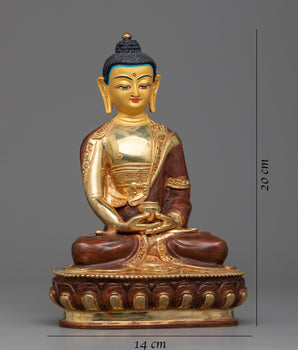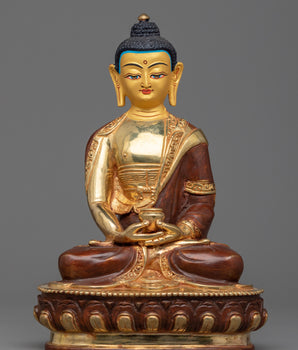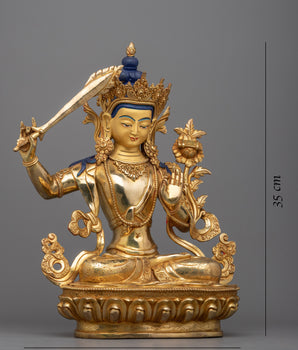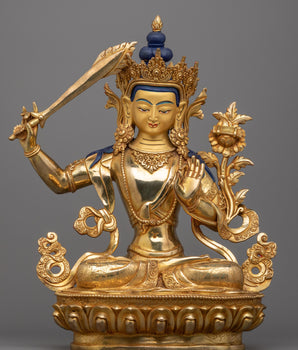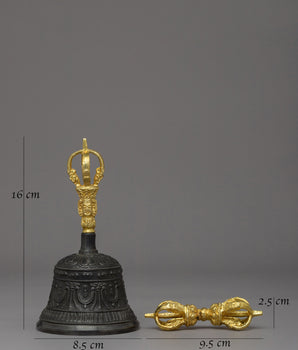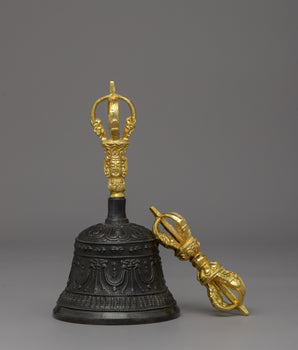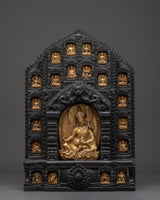
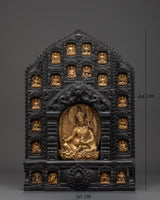

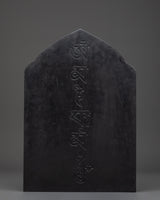
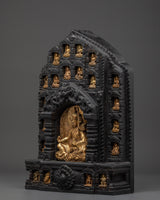
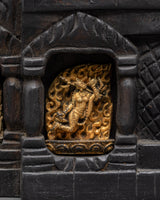
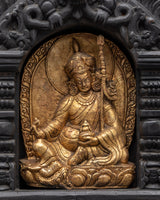

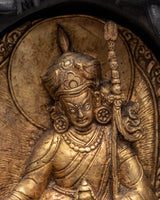
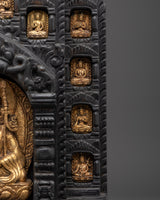
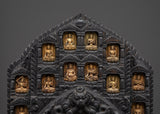
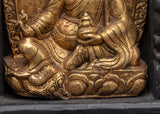
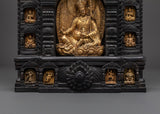
Guru Rinpoche Figure | Tibetan Master Guru

100% AUTHENTIC

HANDMADE

FREE SHIPPING
Handmade Guru Rinpoche Figure | Meditation Altar
-----------------------------------------
Size: 44cm (Height) x 30cm (Width)
Weight: 6.94kg
Material: Wood, Copper Body, Gold Plated
-----------------------------------------
About Our Statue :
Invite the profound presence of Guru Rinpoche (Padmasambhava) into your sacred space with this exquisite handmade sculpture. Standing 44 cm tall and 30 cm wide, the figure is mounted on a wooden base adorned with beautifully crafted side panels that enhance its elegance. Crafted from copper and gold-plated, it radiates divine grace and spiritual power. This remarkable statue serves as a powerful focal point for meditation, altar display, or ceremonial use, helping to deepen your connection to Tibetan Buddhist traditions and invite blessings, protection, and transformation into your life and environment.
The Guru Rinpoche figure is surrounded by 20 intricately detailed deities, bodhisattvas, and protectors, including Amitayus, Manjushri, Shakyamuni, Vairocana, Amitabha, Green Tara, Dzambhala, White Tara, Dakini, and Mahakala. Each figure embodies profound qualities such as compassion, wisdom, protection, and transformation, forming a powerful mandala of sacred energy. This exquisite representation serves as a focal point for meditation and spiritual practice, inviting blessings and guidance from these enlightened beings. Perfect for altars or sacred spaces, it enhances your connection to Tibetan Buddhist traditions and supports your journey toward inner peace and spiritual growth.
Guru Rinpoche, also known as Padmasambhava, is a revered figure in Tibetan Buddhism, often depicted in a regal posture that symbolizes his mastery over both spiritual and worldly realms. Seated on a lotus disc, he embodies purity and enlightenment, showcasing his ability to transcend the distractions and illusions of the material world. Guru Rinpoche is renowned for his crucial role in propagating Mahayana Buddhism in Tibet. His right hand holds the vajra, symbolizing indestructible wisdom that worldly forces cannot shake, while his left hand holds a skull cup attached to a vase of nectar, which represents immortality and the offering of wisdom to sentient beings. Additionally, the skull cup symbolizes his mastery over the cycle of birth and death, offering spiritual sustenance to those seeking liberation. In his other hand, he holds the khatvanga trident, a significant and powerful symbol. The trident’s three prongs represent the Three Jewels of Buddhism: the Buddha, the Dharma, and the Sangha, symbolizing Guru Rinpoche's unwavering commitment to these foundational principles. The trident also signifies victory over ignorance and the destruction of the three poisons: ignorance, desire, and aversion. It serves as a protective tool, safeguarding practitioners from both harmful external and internal forces, while also symbolizing the integration of wisdom, compassion, and skillful means on the tantric path. Guru Rinpoche’s iconography conveys his role as a protector and liberator, capable of overcoming both spiritual and worldly obstacles, guiding practitioners toward enlightenment through his teachings and powerful symbolic presence.
Expertly crafted by Himalayan artisans employing traditional methods, this stunning piece harmonizes artistic elegance with deep spiritual meaning. Its gold-plated finish adds a touch of auspiciousness, while the surrounding deities bring blessings and encourage inner growth. Ideal for altars, meditation spaces, or ceremonial use, this Guru Rinpoche statue makes a thoughtful gift for both practitioners and collectors seeking a meaningful addition to their sacred environment.
Introduction To Guru Rinpoche :
Guru Rinpoche was an instrumental figure in Tibetan Buddhism. In Tibetan Buddhism, Padmasambhava's teachings are said to have an oral lineage (kama) and a lineage of the hidden treasure texts (termas). He is said to appear in visionary encounters to tertöns, and his form is visualized during guru yoga practice, particularly in the Nyingma school. He is revered by Buddhists in Tibet, Nepal, Bhutan, India's Himalayan states, and other countries around the world.
How do you take care of your statues?
• Place them at room temperature, avoiding direct sunlight.
• Make sure that the area where your statue is placed is utterly free of moisture and dust.
• Place it at the highest place on your altar after being consecrated by a Lama/monks. The best practice is to keep them covered inside a glass cabinet.
• Do not use your bare hands or any objects with a rough surface to wipe the face. Directly touching objects with the bare hand can smudge the face, leaving scratches.


















